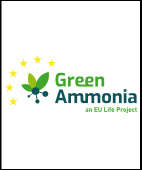
LIFE Project: Market for membrane-based technology for ammonia reduction in livestock farms
- Type Project
- Status In progress
- Execution 2021 -2025
- Assigned Budget 2.537.921,00 €
- Scope Europeo
- Autonomous community Castilla y León
- Main source of financing LIFE
- Project website Web del proyecto
The LIFE Green Ammonia project aims to reduce ammonia (NH 3 ) emissions from excrement in pig and poultry farms, from the farm atmosphere, and from slurry storage tanks. In the project areas in Spain and Portugal, NH 3 emissions from pig and poultry farms are around 7.4 tons/year. The project team aims to reduce these emissions by developing, scaling up, and commercializing two commercial models for NH 3 recovery in gaseous and liquid media. This technology will be based on gas permeable membranes (GPMs) already tested in the LIFE15 ENV ES 000284 LIFE AMMONIA TRAPPING project.
Directive 2016/2284 on national emission reduction commitments (NECs) sets emission reduction commitments applicable from 2020 and 2030. In Spain, reductions of 3% and 16%, respectively, are planned. These limits limit the competitiveness of the EU livestock sector. Ammonia (NH3) causes air pollution, including the formation of particulate matter (PM), and acidification and eutrophication of soil and water, harming vegetation, biodiversity, and human health. In 2017, the agricultural sector was responsible for 3.6 million tonnes of NH3 emissions, or 92% of the EU total. NH3 emissions from livestock account for 64% of this total. NH3 is mainly produced by the decomposition of manure and nitrogenous mineral fertilizers (N). Emissions occur from livestock buildings (44%), manure storage tanks (25%), and land application (31%). Several technologies are focused on N recovery, including gas permeable membrane (GPM) technology developed by the previous LIFE Ammonia Trapping (AT) project. GPM technology presents several advances over other N recovery technologies, such as reverse osmosis, zeolite adsorption, or coprecipitation, as it does not require high pressure or manure pretreatment, can remove NH3 without precipitating Mg and PO4 into struvite, can collect NH3 from the air, and does not disrupt farm operations.
- Transformation of N-NH3 from stored manure into a commercial fertilizer, reducing NH3 emissions by up to 50%. Achieving a 30% reduction in emissions can be considered a suitable performance benchmark for good practice.
- Transformation of N-NH3 from the air in animal stables into a commercial fertilizer, reducing NH3 emissions by up to 35%.
- Replicate and improve the results of the atmosphere model on the Portuguese partner's poultry farm by transferring the commercial airborne model, adapting the model to the new farm conditions.
- Market the results in the livestock sectors through Transfer, Business, and Exploitation Plans.
- Development of membrane panels in the EU to test new materials and contact manufacturing companies.
- Transformation of by-products into certified fertilizers and application of the final product in the field to be tested.
- Develop two strategies to market the fertilizer product: as a liquid fertilizer for fertigation and concentrating the product as an ingredient for the fertilizer industry.
- Promote political initiatives to replicate and transfer project results as Best Available Techniques and support national administrations.
- Develop follow-up tasks to evaluate the project's actions and impact, as well as LIFE KPIs.
- Develop dissemination actions to promote the project results.
- Recovery of nitrogen from manure and the interior of animal sheds at farm scale using new commercial models of gas permeable membrane (GPM) technology, mitigating NH3 emissions from pig and poultry farms, demonstrating their economic profitability and improvement compared to other current NH3 reduction alternatives.
- Liquid manure treatment model reduces NH3 emissions by 50%.
- Air treatment of animal barns in the commercial air model, reducing NH 3 emissions by 35%.
- Farm-scale demonstration of the viability of GPM technology on a pig farm and a poultry farm.
- Transfer of know-how from the air marketing model for the pork sector to the poultry sector. The air marketing model will be tested only in Portugal, as manure on poultry farms is managed as a solid.
- Development of the project technology in two EU countries to test it under two different socioeconomic conditions, as legal requirements, animal handling, manure, cleaning activities, and other agricultural activities may differ.
- Export of N off the farm in the form of certified fertilizers.
- Generation of two types of certified N-based fertilizers, one in the form of concentrated ammonium sulfate salt - (NH 4 ) 2 SO 4 - and another in liquid form to be used in fertigation.
- Coordinator/entity name: Ruta Kronberga
Postal address: Plaza de Santa Cruz, 5, 47002, Valladolid,
The project contributes to achieving the objectives of EU Directive 2001/81/EC on national emission ceilings for certain air pollutants; Directive 2016/2284/EU on national emission reduction commitments (NECs); and Directive 2010/75/EU on industrial emissions. The project also contributes to EU policies related to the protection of water bodies from pollution caused by nitrates used in agriculture (Directive 2000/60/EC and Directive 91/676/EEC), as ammonia emissions are deposited in soil and water, where they cause problems due to eutrophication and acidification.
- Fundación General de la Universidad de Valladolid
- VALE JUNCO(Quinta do Vale Junco, Sociedade Agropecuária Lda.)
- AGROCESA(Agropecuaria del Centro, AGROCESA S.A.U.)
- AGROPOR(Agro-Porciono Manso S.L.)
- UVa(Universidad de Valladolid)
- ITACyL(Instituto Tecnológico Agrario de Castilla y León)







